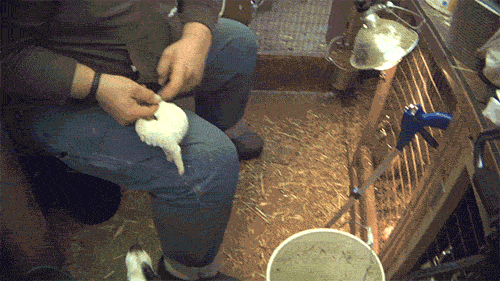To give dogs so-called “desirable” traits, unscrupulous humans perform cruel, disfiguring surgeries like ear cropping and tail docking that cause dogs immense suffering. PETA explains why you shouldn’t put your pup through these painful, unnecessary procedures.

Why Shouldn’t I Have My Dog’s Tail Docked or Ears Cropped?
Ear cropping and tail docking are purely cosmetic surgeries that consist of mutilating the natural length and shape of a dog’s ears or tail. When a dog’s ears are cropped, they’re cut and then taped to stand upright when they would otherwise flop over, and dogs with docked tails are left with just a nub. Dogs communicate with their human companions and other dogs using their ears and tails. Depriving them of their primary means of expression is unconscionable.
“Ear-cropping and tail-docking are not medically indicated nor of benefit to the patient. These procedures cause pain and distress and, as with all surgical procedures, are accompanied by inherent risks of anesthesia, blood loss, and infection.”
—The American Veterinary Medical Association
A PETA undercover investigator recorded a Jack Russell terrier breeder slowly cutting and twisting the tails off puppies. This method of tail docking is used by many breeders, often without any pain relief.

In the U.S., only Maryland and Pennsylvania have laws that restrict tail docking. Connecticut, Maryland, New Hampshire, New York, and Pennsylvania all prohibit ear cropping unless the procedure is done by a licensed veterinarian with the animal under anesthesia.
Mutilating a dog’s tail can cause excessive bleeding, infection, necrosis, chronic pain, and problems with the development of the pelvic muscles. Dogs whose tails have been docked are also more likely to develop incontinence. It’s absurd to perform medically unnecessary procedures that have lasting consequences for dogs’ health. Dogs are not accessories.
What About My Dog’s Dewclaws—Should They Be Removed?
Front dewclaws are akin to human thumbs, but back dewclaws occur only in some dogs and are not attached to the skeleton.

Removal of the back dewclaws can prevent injuries, as the dangling digits can easily become caught on something and be painfully torn off. Typically, removal of the back dewclaws is performed during spaying or neutering, so the dog is already under anesthesia and will have access to pain medication afterward.
Removal of the front dewclaws, however, is usually unnecessary and can cause serious problems later in life. Without front dewclaws, there is a greater risk of damaging the carpal ligaments, which can lead to arthritis in the wrist, and that can put stress on other joints of the leg and spine.
Is Debarking Cruel?
Debarking, or devocalization, is an invasive surgical procedure that involves removing a large amount of laryngeal tissue and causes a great deal of pain postoperatively. Barking is a dog’s means of expressing many feelings—fear, frustration, pain, boredom, excitement, and joy. Physically preventing barking strips dogs of their ability to communicate with their voices. Because this procedure is unnecessary and inherently cruel, many veterinarians condemn it and refuse to perform it. Six states in the U.S.—California, Maryland, Massachusetts, New Jersey, Pennsylvania, and Rhode Island—prohibit this procedure except when it’s ruled medically necessary by a licensed veterinarian.

Don’t accept debarking as a solution to the problem of constant barking. Instead, deal with the problem for what it is: a symptom of boredom, loneliness, or anxiety. Your dog is communicating that there’s something wrong, and whether or not we agree with that analysis, the barking is going to continue until the problem is solved. Thankfully, there are simple ways to limit problematic barking:
- First and foremost, dogs who spend all day outdoors alone in a yard should be allowed inside as part of the family. Dogs are pack animals—they need companionship! And dogs who spend all day in an empty house need it, too. Arrange for a family member, friend, trusted neighbor, or professional to stop by mid-day to let the pup out and provide some relief and entertainment.
- Consult our guide to finding a humane dog trainer, or call an animal behaviorist or a helpful veterinarian for a recommendation. Never use shock, citronella, or e-collars as a solution—they can make the barking much worse and cause dogs emotional and physical distress.
- Schedule an appointment with your veterinarian to rule out any underlying health problems.
- Ask your vet or local humane society to refer you to a dog walker, doggie daycare center, or dog park, where dogs can bark all they want.
I’m a Responsible Dog Guardian—What Procedures Should My Dog Have?
While procedures like ear cropping, tail docking, and debarking are cruel, many other types of surgery can help your dog enjoy a long and happy life. The single most important thing that we can do for dogs is to have them spayed or neutered. Spaying and neutering are routine, affordable surgeries that can prevent unwanted animals from being born, only to suffer and struggle to survive on the streets, be neglected or abused by cruel people, or be euthanized in animal shelters for lack of a loving home. These operations also help your canine companion live without risk of health problems such as testicular cancer and uterine infections.
Text VEG to 73822 to get the latest vegan lifestyle tips, recipes, and urgent action alerts texted right to your phone.
Terms for automated texts/calls from PETA: https://peta.vg/txt. Text STOP to end, HELP for more info. Msg/data rates may apply. U.S. only.







